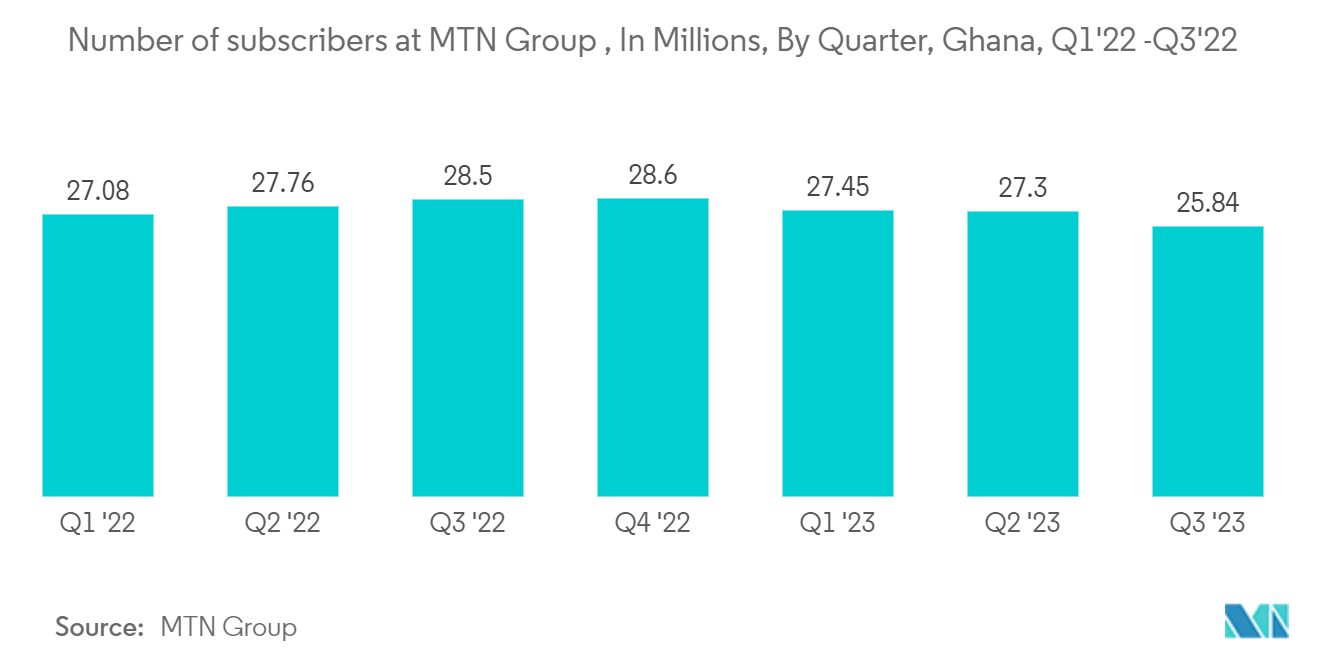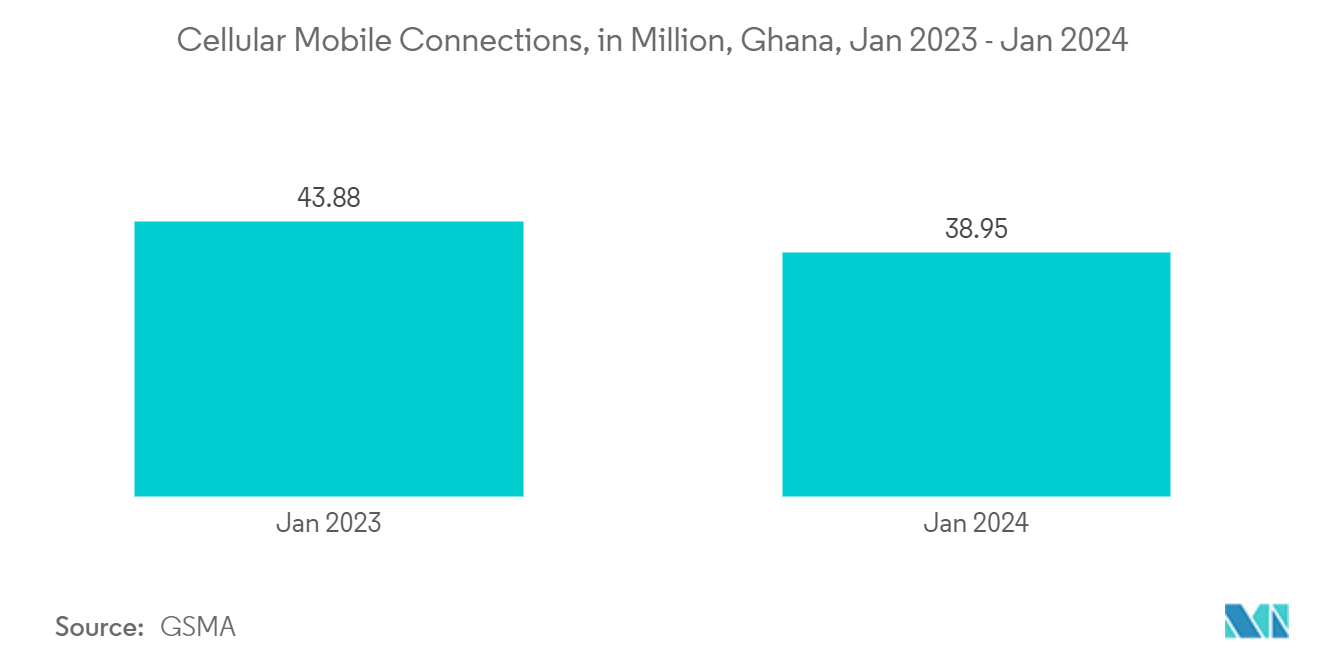Market Trends of Ghana Telecom Industry
Mobile Network is Expected to Propel the Market
- Smartphones are used for both personal and professional purposes. Apps enable various activities, such as access to social media platforms, health and wellbeing tracking, and mobile payments. Due to an increase in the number of smartphone users connecting to faster networks and using more significant amounts of data, smartphone capacity has also increased mobile internet traffic. This has created new opportunities for networks, service providers, and the broader Ghana telecommunications industry to meet this growing demand. Additionally, they spend most of their time using social and communication apps. Businesses connect with their customers in countless ways, given how frequently and intensely they use their smartphones. Hence, these factors will boost smartphone adoption in the country during the forecast period.
- Ghana's internet infrastructure has grown significantly due to the increasing demand for internet access to support its economic growth. Additionally, the government has invested in developing mobile networks, enabling many country locations to access mobile telecom services, such as mobile broadband. Enterprises in the country need access to dependable, high-speed internet because of the country's digital transformation and online services, creating an opportunity for mobile broadband connectivity because the internet through mobile broadband architecture is more portable and affordable due to the application of SIM cards in mobile broadbands.
- In 2023, MTN committed to investing USD 1 billion in Ghana over the next five years. Despite this, Ghana's 4G adoption remains low, with only 15% of mobile users utilizing the technology by mid-2023. MTN Ghana stands out as the nation's primary 4G provider, boasting 5.7 million active 4G subscriptions by June 2023, a significant portion of its 27.8 million total mobile user base. In contrast, Vodafone Ghana had a mere 341,600 4G subscriptions from its 7.3 million mobile users, while AirtelTigo and Glo Mobile lagged, reporting no 4G users. Ghana's regulatory body intensified its efforts against unregistered SIM cards, leading to the disconnection of approximately 9 million SIM cards in June 2023, until users completed mandatory registration.
- Moreover, as the technology reduces the need to develop additional instrumentation that must be managed and operated, NB-IoT prepares for a wider audience. NB-IoT can connect Narrowband IOT applications directly and will likely become more widespread as urbanization continues. Narrowband-IoT, also known as LTE Cat NB1, is a Low-Power Wide-Space (LPWA) network technology typically used to connect many sensitive sensors and devices via a wireless cellular network. The commissioned spectrum is where NB-IoT devices operate, providing users with safe and reliable property.
- The voice services include the voice telecom services provided by the country’s telecom operators through wire-based architecture and technology, such as landline phones, which previously dominated the telecom market in the country. Still, with the advancement of cell phones and other wireless devices for communication, the wired-based voice service is registering a continuous decrease in adoption. In addition, wire-based telecommunication services are being utilized for data services in the country because of their high stability, but due to the less flexibility and portability, wired voice services are gradually being replaced by wireless voice services, including the Voice over Internet Protocol.

Wireless Segment is Expected to Hold Significant Share
- The Government acknowledges the rapid evolution of technology and markets in the telecommunications sector, a trend that is expected to persist in the coming years. Recognizing the need for adaptability, the traditional telecommunications market in Ghana must pivot to accommodate new services, diverse marketing strategies, and evolving customer preferences. While an immediate overhaul of the current market structure is impractical, this Policy aims to outline a foundational vision for future market structures that will best serve Ghana's populace and enterprises. Additionally, it aims to initiate procedures and incentives that will steer the market towards this envisioned future.
- Moreover, Securing formal authorization for a designated frequency band is imperative for any domestic telephone operator aiming to offer services through wireless radio transmission. Once granted, the operator gains exclusive rights to utilize the spectrum for public telephone services, as outlined in their license terms. However, operators are bound by stringent service quality standards and must ensure their transmissions do not unduly interfere with other licensed holders' signals.
- The country has developed a competitive telecom business. The market's prospects improve as more international investors and players enter, and government support develops. Both private and public sector companies are actively investing in the market, supporting its growth. According to GSMA Intelligence data reveals that Ghana boasted 38.95 million cellular mobile connections at the onset of 2024, representing a penetration rate of 113.1% of the population. Additionally, Meta's planning tools highlight a significant growth in Instagram's potential ad reach in Ghana, surging by 500,000 users, a notable 29.4% increase from January 2023 to January 2024.
- The are various trends that are expected to drive the market. For example, The incorporation of advanced technology in the telecom sector is expected to drive the market. For instance, in the telecom sector, organizations are increasingly recognizing that while AI presents significant opportunities, it also brings formidable challenges. To succeed, telcos must gather extensive datasets, even those from external partners, swiftly transfer and process this data, and promptly leverage the insights to enhance business outcomes.
- Further, trends that may drive the studied market in the region include Cloud computing is familiar. Still, most telecom businesses rely on proprietary data centers to house most of their IT infrastructure. This will change in the future of telecoms as corporations shift critical infrastructure to the cloud. This transfer will increase scalability and allow telecom providers to adapt to swings in demand more effectively. This scalability will allow these organizations to bring new services to market more quickly and analyze demand before making large, unrecoverable infrastructure expenditures in goods that fail to acquire traction. This will be especially crucial in the context of 5G, as new apps and digital services join the market during an economic slump, which can greatly impact client demand.


